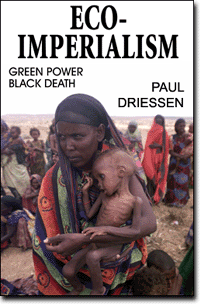Response to December 12, 2003 Bangladesh Daily Star article
by Nizam Ahmad and Paul K. Driessen
Bangladesh Daily Star
December 2003
Jurassic Park author Michael Crichton recently said “the greatest challenge facing mankind is distinguishing reality from fantasy, truth from propaganda,” especially in the realm of environmentalism. Few articles better illustrate the importance of meeting this challenge than your December 12 column, “Disease threat will worsen as global warming bites.”
In the interest of furthering your “commitment to the people’s right to know,” your readers should know the facts. The World Health Organization (WHO) report is nothing more than a recap of the scariest, most extreme scenarios from the global warming horror movie script. All are based on meaningless computer models (garbage in – garbage out), none bears any relationship to actual evidence, and every figure cited is from the extreme end of the most extreme computer projections.
Over 18,000 scientists (including hundreds of meteorologists and climate specialists) have signed a statement, saying they see “no evidence” that humans are causing climate change. Computer models are not evidence, especially when they: cannot accurately predict one year in advance, much less 100 years; assume the world’s energy production and pollution control technologies will remain the same for the next century; fail to recognize the crucial role of solar and cosmic influences on the Earth’s climate; and ignore our planet’s long history of warming and cooling periods, ice ages and near-tropic conditions.
Surface temperature gauges are too few for accurate measurements, especially when nearly all are contaminated by heat from the cities and airports where they are located. Satellite and weather balloons show at most a 0.1 degree per decade temperature increase. That small change, especially when accompanied by increases in the vital plant nutrient carbon dioxide, will improve agriculture all over the world.
Malaria? Warm climates make no difference. As tropical disease expert Paul Reiter has pointed out many times, malaria was common in the United States, Canada and Europe – even in Alaska – until those countries used DDT to eliminate it. We almost got rid of it in Bangladesh, using DDT, until pressure from environmental NGOs caused us to stop using this miracle pesticide and mosquito repellant. Then malaria returned with a vengeance.
Even worse, it is the WHO itself that now opposes the use of DDT and other pesticides, and promotes drugs and bed nets that work only part of the time. So the very organization that is hyping this global warming and malaria scare is itself responsible for much of the current malaria problem in Africa, Bangladesh and India.
Rising sea levels? They have been rising at 18 to 35 cm a century since the last ice age, when our oceans were 100 meters lower than they are now.
Diarrhea? This disease kills millions every year because developing countries can’t get safe drinking water. And a primary reason they can’t is that environmental NGOs – the same ones pushing climate scares – adamantly oppose the construction of hydroelectric and fossil fuel projects that would provide electricity to modernize those societies and provide clean water.
Malnutrition? Once again, radical Greens oppose one of the most promising technologies for reducing this scourge: genetically engineered crops that provide more proteins, grow better under harsh conditions, reduce pesticide use and soil erosion, increase agricultural productivity, and give poor farmers a chance to compete with heavily subsidized US and EU farmers.
Not only does your story uncritically repeat WHO fantasies and propaganda. In so doing, it promotes dangerous and fraudulent “solutions” to make-believe problems. These expensive policies could plunge the world into a long-term recession, thus preventing us from solving real problems that we will no longer be able to afford to address, and costing still more millions of lives.
As Mr. Crichton urges, “it’s time to abandon the religion of environmentalism, and return to the science of environmentalism, and base our public policy decisions firmly on that.”
